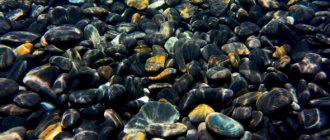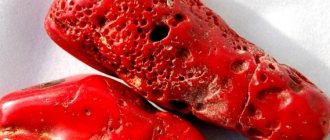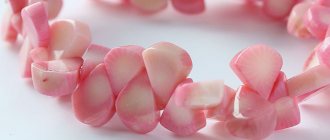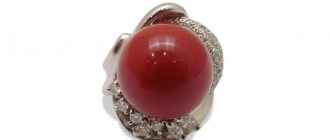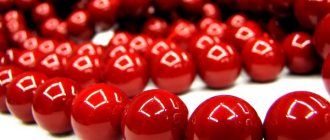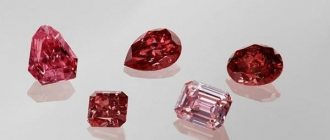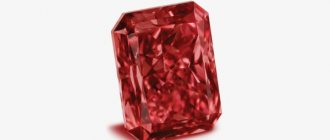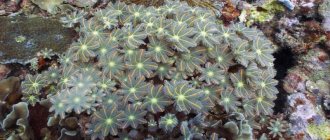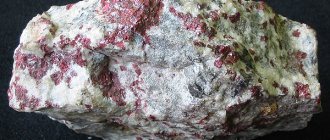genus of sea corals
For the red coral mushrooms, see Ramaria araiospora.
| Precious coral | |
| Scientific classification | |
| Kingdom: | Animalia |
| Type: | Cnidaria |
| Class: | Anthozoa |
| Order: | Alcyonacea |
| Family: | Coralliidae |
| Genus: | Corallius Cuvier, 1798 |
| Variety | |
| 31 species, see text. | |
Precious coral
, or
red coral
, is the common name given to a genus of sea coral,
Corallium
. The distinctive feature of gem corals is their durable and brightly colored red or pink-orange skeleton, which is used to make jewelry.
Habitat[edit]
Red corals grow on rocky bottoms with low sediment levels, usually in the dark - either at depth or in dark caves or crevices. Original species of C. rubrum
(formerly
Gorgonia nobilis
) is found mainly in the Mediterranean Sea.
It grows at depths ranging from 10 to 300 meters below sea level, although the shallower of these habitats have been largely depleted by harvesting. [1] In the underwater caves of Alghero, Sardinia (hereafter "Riviera Coral") it grows at depths of 4 to 35 meters. The same species is also found in Atlantic areas near the Strait of Gibraltar, on the Cape Verde Islands and off the coast of southern Portugal. [1] Other Corallium
are native to the western Pacific, especially Japan and Taiwan; [2] They occur at depths of 350 to 1,500 meters below sea level in areas with strong currents. [1]
Physicochemical characteristics
Coral is fragile and has a porous structure. It is built mainly from calcium salts, the mineral formula is CaCO2. Special shades are obtained due to iron salts and specific algae living in symbiosis with polyps.
During jewelry processing, the stone is polished to achieve a glassy shine. In this case, the formation has low transparency and very rarely a pearlescent sheen (some pink types).
RELEVANT: Cacholong is a semi-precious stone of amazing beauty
Corals are not resistant to high temperatures and the effects of salts and acids. Precious products made from ocean stone require careful handling: they should not be dropped or beaten, transported with care, not exposed to the sun and not washed with fresh water.
Some particularly fragile stones are treated with wax to fill the pores of the stone. However, expensive types can be compared to ivory in strength.
Coral powder has antibacterial properties, but can also cause allergies and individual intolerances when interacting with the skin, so before buying expensive products you need to “make friends” with a small stone. People with seafood allergies should pay special attention to this. Beads and bracelets made of bare stone can pose a danger, but if the mineral is inlaid in gold or silver, the threat is minimal even for allergy sufferers.
Types[edit]
The following species are known in this genus: [4]
- Corallium abyssale
Bayer, 1956. - Corallium Bathyrubrum
Simpson & Watling, 2011 - Corallium bayeri
Simpson & Watling, 2011 - Coralium bornans
Bayer - Corallium boshuense
Kishinouye, 1903 - Corallium carusrubrum
Tu, Dai & Jeng, 2012 - Corallium ducale
Bayer - Corallium elatius
Ridley, 1882 - Corallium gotoense
Nonaka, Muzik & Iwasaki, 2012 - Corallium halmaheirense Hickson
, 1907 - Coralium imperial
Bayer - Corallium johnsoni
Gray, 1860 - Corallium kishinouyei
Bayer, 1996 - Corallium konojoi
Kishinouye, 1903. - Corallium laauense
Bayer, 1956. - Corallium maderense
(Johnson, 1899) - Corallium medea
Bayer, 1964 - Corallium niobe
Bayer, 1964. - Corallium niveum
Bayer, 1956 - Corallium occultum
Tzu-Hsuan Tu et al., 2015 - Corallium porcellanum
Pasternak, 1981 - Corallium pusillum
Kishinouye, 1903. - Corallium regale
Bayer, 1956 - Corallium rubrum
(Linnaeus, 1758). - Corallium secundum
Dana, 1846 - Corallium sulcatum
Kishinouye, 1903 - Corallium taiwanicum
Tu, Dai & Jeng, 2012 - Coralium tricolor
(Johnson, 1899) - Corallium uchidai
Nonaka, Muzik & Iwasaki, 2012 - Corallium vanderbilti
Boone, 1933 - Corallium variabile
(Thomson & Henderson, 1906).
Like a gem [edit]
Queen Farida of Egypt red coral parure by Ascione, made in 1938 in Naples, Coral Jewelry Museum
Chinese coral sculpture. Gift of Mr. and Mrs. Charles D. Field, 1988, and gift of Alice Meyer Buck, 1968.
The hard frame of red coral branches is naturally matte, but can be polished to a high-gloss shine. [2] It has a range of warm reddish pink colors from pale pink to deep red; word coral
also used to refer to such colors. Due to their intense and long-lasting color and luster, precious coral skeletons have been collected since ancient times for decorative purposes. Coral jewelry has been found in ancient Egyptian and prehistoric European burials [3] and continues to be made to this day. It was especially popular during the Victorian era. [5]
The precious coral has a hardness of 3.5 on the Mohs scale. [6] Due to its softness and opacity, coral is usually cut as a cabochon
or used to make beads. [7]
Who is not suitable for coral?
According to astrologers, the stone should not be worn by Capricorns and Virgos. Their stable earthly energy comes into conflict with a living stone, which is why it can negatively affect their character.
RELEVANT: Cat's eye stone - what is the power of this magical talisman
Also, women should give up blue corals - they are considered a purely masculine stone, and wear red ones as a special decoration:
- for business meetings to increase determination, confidence, acumen;
- for holidays and dates to enhance sexual energy;
- for celebrations where the wearer is the center of attention, such as a birthday party.
It must be taken into account that strong masculine energy presents a personality like a magnet and attracts attention. Frequent contact can bring excessive effects: recklessness, aggressiveness, vanity.
Coral should not be worn by melancholic people; it is ideal for extroverts, active and public people.
History of trade[edit]
6 strand necklace
, Navajo (Indians), ca. 1920s, Brooklyn Museum
Coral earrings.
Red coral precious raw gemstone
At the beginning of the 1st millennium, there was a significant trade in coral between the Mediterranean Sea and India, where coral was valued as a substance endowed with mysterious sacred properties. Pliny the Elder notes that, before great demand from India, the Gauls used it to decorate their weapons and helmets; but by that time the eastern demand was so great that it was very rarely seen even in the regions that produced it. The Romans hung coral branches around the necks of children to protect them from outside danger, and many medicinal properties were attributed to this substance. Belief in the power of coral as a charm continued into the Middle Ages and into the early 20th century in Italy, it was worn as protection against the evil eye, and by women as a cure for infertility.
From the Middle Ages onwards, securing coral fishing rights off the African coast was a matter of considerable competition between Mediterranean communities in Europe.
The history of Torre del Greco is so intertwined with the history of corals that it forms an inextricable pair, and has been documented since the fifteenth century. In 1790, the Royal Coral Society was founded in the city of Torre del Greco, which was engaged in the development and sale of coral fish. This indicates that coral fishing flourished in the city for many years. [ citation needed
]
It was also adopted on December 22, 1789 by Ferdinand IV of the Bourbon Coral Code (prepared by the Neapolitan jurist Michael Florio) with the intention of regulating coral fishing in those years in which, in addition to the sailors of Torre del Greco, local residents participated. and in Trapani. This resolution did not have the expected success. Since 1805, when he founded the first coral factory in Torre del Greco (Paul Bartholomew Martin, but of French Genoese origin), the golden age of coral production began in the city located on the slopes of Vesuvius. , because communal coral fishing was increasingly under the control of the fishermen of Torre del Greco. From 1875, Torre del Greco began working with Sciacca corals, and in 1878 a coral production school was built in the town (which closed in 1885 and reopened in 1887), with a coral museum created in 1933. Then it was time to process the Japanese corals found in the markets of Madras and Calcutta.[ citation needed
]
Another story: instead, for a short period, Tunisian fisheries were secured for Spain by Charles V; but the monopoly soon passed into the hands of the French, who held the right until the revolutionary government opened trade in 1793. For a short period (around 1806) the British government controlled the fishery, but it later returned to the hands of the French authorities. Before the French Revolution, most of the coral trade was centered in Marseille, but then largely moved to Italy, where mining and processing of the raw material was concentrated in Naples, Rome and Genoa. [8]
What is the price
The cost of corals depends on the size of the stones, their color and density. In addition, the price of the products will include the processing of minerals and the skillful work of the craftsman. Corals are polished and often coated with special varnishes and wax to preserve the integrity of the pieces.
The average cost of coral is equal to pearls. There are artificial stones that are recreated from coral powder. This product has healing properties and is cheaper. In addition, the mineral is counterfeited by making beads from plastic.
Natural coral cannot be cheap due to the depletion of the natural resource and the ban on mass mining. When buying a sea mineral, pay attention to the fact that the stones are protected from abrasion, for example, there should be knots between the beads.
If you feel that this unique and amazing stone resonates in your heart, buy yourself a piece of jewelry for good luck, and let it be as bright as the energy of the “living” mineral itself.
In culture[edit]
| This section requires additional links for verification . |
The origin of corals is explained in Greek mythology by the story of Perseus. Petrified by the Whale, a sea monster threatening Andromeda, Perseus placed Medusa's head on the river bank while he washed his hands. When he lifted her head, he saw that her blood had turned the algae (in some versions, reeds) into red coral. Thus, the Greek word for coral is "Gorgea", since Medusa was one of the three Gorgons. [9]
Poseidon lived in a palace made of coral and precious stones, and Hephaestus first created his works from coral.
The Romans believed coral could protect children from harm, as well as heal wounds made by snakes and scorpions and diagnose diseases by changing color.
- In Hindu astrology, red coral is associated with the planet Mars or Graha-Mangala and is used to please Mars. It should be worn on the ring finger.
- A branch of red coral features prominently on the city coat of arms of the city of Alghero, Italy.
- In Islam, coral is mentioned as one of the pearls of paradise.
- Among the Yoruba and Bini peoples of West Africa, jewelry made of precious red coral (especially necklaces, bracelets and anklets) is a sign of high social status and is therefore worn by titled kings and chiefs.
Medicinal properties
The valuable properties of coral stone have been established for a long time and are actively used in medicine. First of all, coral is a source of pure calcium, so it is consumed in powder form as a supplement for the treatment of bone diseases and is used in dental surgery.
In addition, the stone is a sorbent, removes toxins from the body, purifies the blood and even quickly stops the effect of poisons from snake bites or dangerous insects.
The stone is said to help with sore throats and frequent colds. Some experts claim that corals help you lose weight.
When used externally in lithotherapy, the mineral helps relieve headaches, improve blood circulation, improve sleep and nervous activity, and eliminate symptoms of depression. There is evidence that women in some countries used coral as a contraceptive, and men as an aphrodisiac.
Saving [edit]
Intensive fishing, especially in shallow waters, has harmed the species along the Mediterranean coast, where colonies in depths less than 50 meters have declined significantly. Fisheries and now climate change threaten their conservation. The three oldest marine protected areas in the Mediterranean - Banyuls, Carry-le-Rouet and Scandola off Corsica - support significant populations of C. rubrum
. Since protection was established, colonies have increased in size and increased in size at shallow and deep depths. [10] [11]
Links[edit]
- ^ abcd "Species of Corallium". ARKive
. Archived from the original on June 20, 2007. Retrieved February 15, 2007. - ^ ab "Gemstones: Coral". Archived from the original on February 9, 2007. Retrieved February 15, 2007.
- ^ a b "Red Coral". Marenostrum
. Retrieved February 15, 2007. - "WoRMS - World Register of Marine Species - Corallium Cuvier, 1798". marinespecies.org. December 21, 2004. Retrieved October 9, 2013.
- Anderson, Catherine (2008). "Coral Jewelry". Victorian Review
.
34
(1): 47–52. DOI: 10.1353/vcr.2008.0008. JSTOR 41220397. - "Jewelry Center". Retrieved February 15, 2007.
- Balzan, Francesca; Deidun, Alan (2010). "Notes on the history of coral fishing and coral artefacts in Malta - Meaning of coral: apotropaic, medicinal, symbolic, precious". In Joseph F. Grima (ed.). 60th Anniversary of the Malta Historical Society: Commemorative Dates
. Zabbar: Veritas Press. pp. 435–454. ISBN 978-99932-0-942-3. OCLC 779340904. Archived from the original on March 25, 2022. - Jump up
↑ Chisholm, Hugh, ed.
(1911). "Coral". Encyclopedia Britannica
.
7
(11th ed.). Cambridge University Press. paragraph 131. - "Ovid's Metamorphoses". Metamorphoses
. Retrieved November 6, 2014. - "Marine protected areas conserve Mediterranean red coral". sciencedaily.com. May 11, 2010. Retrieved October 9, 2013.
- Linares, C.; Bianchimani, O.; Torrents, O.; Marshall, C.; Drap, P.; Garrabou, J. (2010). "Marine protected areas and the conservation of long-lived marine invertebrates: Mediterranean red coral". Marine Ecology Progress Series
.
402
: 69. Bibcode: 2010MEPS..402 … 69L. DOI: 10.3354/meps08436. LVP: 10261/79508.
